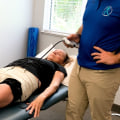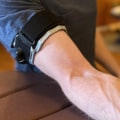Doppler ultrasound or plethysmography may be used to determine blood flow to the limb. The cuff is inflated to a specific pressure where arterial blood flow is completely occluded. This is known as limb occlusion pressure (LOP) or arterial occlusion pressure (AOP). Occlusion training involves disrupting blood flow to the limbs at work.
A tourniquet or bracelet is placed around the limb and the pressure increases as the workout begins. Personalized blood flow restriction training is an exercise modality that involves the use of a cuff to occlude venous blood flow outside a limb while restricting arterial blood flow to a limb. During properly performed BFR, blood can enter the muscle through arterial flow; however, the veins are restricted to partially prevent blood from leaving the working muscle. There is increasing evidence to support the use of blood flow restriction at rest, combined with aerobic training, or combined with low-load resistance training to mitigate disuse muscle atrophy and improve hypertrophic and strength responses in skeletal muscles.
This study found that a wider cuff required less absolute pressure to restrict blood flow at any given% of AOP, but that a narrow cuff inflated to a higher absolute pressure (but the same% AOP as the wide cuff) had a similar reduction in blood flow. In addition, the decrease in venous blood flow results in the accumulation of blood within the capillaries of the occluded limbs, often reflected by visible erythema. Blood markers of oxidative stress include protein carbonyls, lipid peroxides and blood glutathione, as well as antioxidant systems. We recommend using an FDA-listed custom tourniquet system for personalized blood flow restriction training.
However, when used in an environment controlled by trained and experienced personnel, blood flow restriction training appears to provide a safe training alternative for most people, regardless of age and training status. The effects of blood flow restriction on the musculature of the upper body located distal and proximal to the applied pressure. Effect of different types of lower body resistance training on arterial compliance and blood flow This covers the use of blood flow restriction to improve muscle strength and hypertrophy by training with resistance and aerobic exercise and prevention of atrophy muscle using the technique passively. The three main factors believed to cause this are hyperability to form a blood clot (hypercoagulability), vascular damage, and vascular occlusion of blood flow.
Hemodynamic and hormonal responses to short-term low-intensity endurance exercise with reduced muscle blood flow. Hemodynamic responses during endurance exercise of lower limbs with blood flow restriction in healthy subjects. Increased maximum oxygen uptake after 2 weeks of walking training with blood flow occlusion in athletes.



Leave Reply